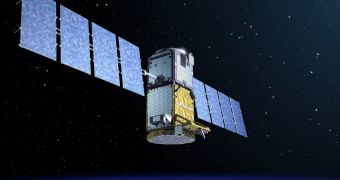The second satellite of the GIOVE Missions has been launched into space on Sunday, April 27, from the Baikonur cosmodrome in Kazakhstan with the help of a Russian Soyuz Rocket and inserted into orbit around Earth. During the Launch and Early Operations Phase, the spacecraft will execute a series of system verifications including telemetry and telecommand, propulsion, power, thermal control, and attitude and orbit control.
GIOVE-B will be controlled from the Telespazio's Fucino Space Centre in Italy, and will only be commissioned after the LEOP stage is complete.
The first task is to extend the solar panels in order to charge the batteries of the spacecraft, because since it was loaded in the Soyuz rocket it has been operating on battery power alone. The Sun-pointing maneuver will ensure that the spacecraft is aligned to an optimal position in relation to the Sun and electric energy is being produced efficiently.
This particular pointing maneuver should have been carried out by the reaction wheels, a series of brushless electric motors able to rotate the spacecraft by harvesting inertial momentum only. Unfortunately, the brushless electric motors couldn't be activated due to a glitch in the maneuvering software and flight controllers were forced to use the spacecraft's thrusters. A software patch has already been applied and GIOVE-B is now operating at nominal parameters.
Mission controllers chose to use brushless electric motors to rotate the spacecraft because electric energy is basically unlimited into space, unlike thruster fuel. By doing so, they hope to extend the mission of the GIOVE-B satellite as much as possible. Although the first pointing maneuver using the electric motors has failed, the spacecraft will have many other chances to put them to use.
The thrusters on the other hand are only destined to provide orbital control.
With the LEOP phase over, the payload of the spacecraft can finally be turned on and the satellite commissioned. GIOVE-B is carrying on board two microwave amplifications by stimulated emission of radiation clock, one with rubidium and the other using hydrogen, and a navigation signal generator. Amongst the last systems to be powered we'll find the L-band solid-state power amplifiers, which will generate signals that will be transmitted back to Earth. The first such signal is expected to be received in a couple of days.

 14 DAY TRIAL //
14 DAY TRIAL //